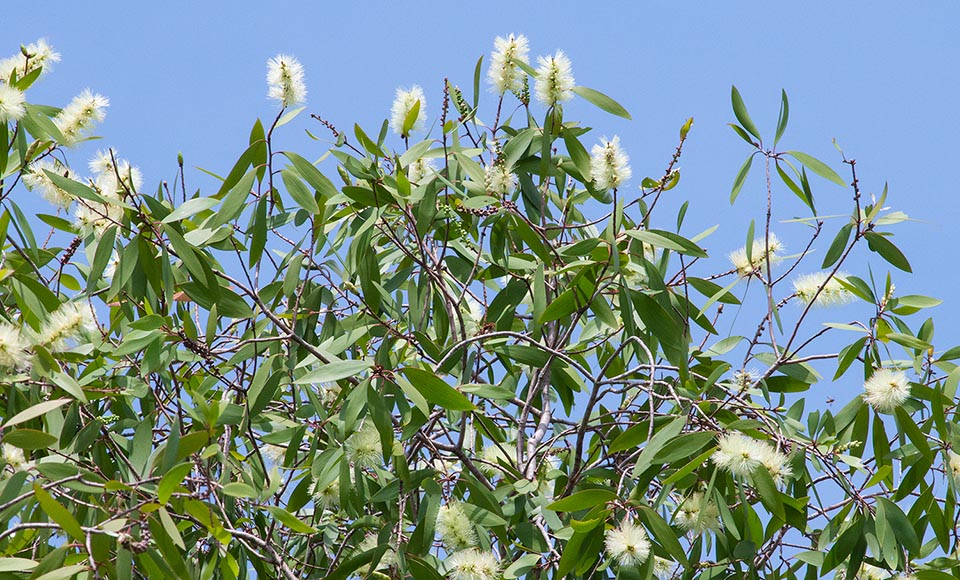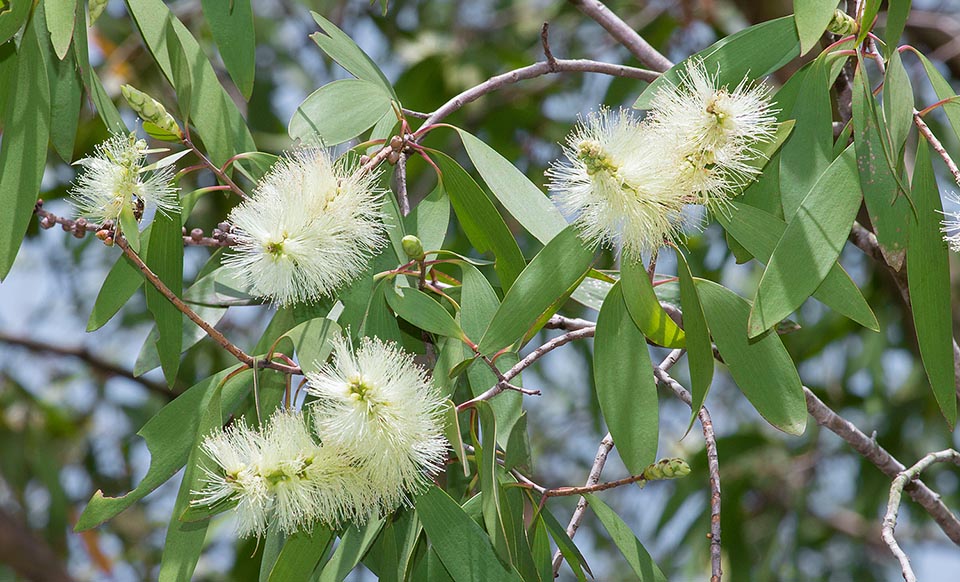Family : Myrtaceae

Text © Pietro Puccio

English translation by Mario Beltramini

The Melaleuca cajuputi exceeds, in the swampy primary forests of South-East Asia, the 30 m of height © Giuseppe Mazza
The name of the genus is the combination of the Greek adjectives “μέλας” (melas) = black and “λευκός” (leukόs) = white, with reference to the colour of the bark, initially white that then turns blackish while ageing; the specific name comes from the Malay “kaju putih” that means “white wood”.
Common names: cajuput tree, paperback tea tree, swamp tea tree (English); smach chanlos (Cambodia); baru galang, gelang, irano, kayu puthi, waru gelang (Indonesia); gelam (Malaysia); samet (Thailand); chè dong tran (Vietnam).
The Melaleuca cajuputi Powell (1809) is an evergreen tree with erect trunk, that in the old specimens in nature may exceed the 30 m of height and 1 m of diameter, with soft and spongy white-greyish bark flaking off in long thin laminae; at the base of the trunk, in the zone subject to periodical floodings, may develop aerial roots.
The leaves, on a 0,4-1 cm long petiole, are alternate, simple, lanceolate, slightly falcate, with mucronate tip and entire margin, 5-12 cm long and 1,2-3 cm broad, coriaceous, rigid, of dark green colour, that when rubbed emit a pungent smell; the young buds are covered by a thick down.
The inflorescences are axillar and cylindrical terminal spikes, 4-10 cm long, with pubescent rachis and white, greenish white or cream colour, arranged in groups of three. Almost cylindrical calyx with 5 lobes, about 2 mm long, 5 petals with obovate lamina, 2,5-3 mm long and broad, and white stamens united in 5 groups, each one with 5-12 stamens merged at the base, 8-10 mm long. The flowers are hermaphroditic, but proterandrous (the male organs mature before the female ones, this prevents the self-fecundation favouring the crossed one), and are pollinated mainly by insects. The fruits are globose capsules, about 3 mm long and of 4 mm of diameter, persistent for long time, containing tiny linear seeds.

From the alternate, simple, lanceolate leaves they extract an oil containing cineole, with antibacterial, anti-inflammatory and insect-repellent properties © G. Mazza
Since remote times the leaves are utilized in the popular medicine for various pathologies and starting from the XIX century, in many countries of south-eastern Asia they have begun its cultivation for the extraction of the oil from the leaves due to its medicinal virtues. The oil, which contains 5 to 60% of cineole, has antibacterial and anti-inflammatory properties and is utilized mainly for external use, the internal use may have various side effects; it has proved to hold also insect-repellent properties. Moreover, it is added, due to its fragrance, to balms, detergents and cosmetics. Species cultivable in the tropical and subtropical climate regions in full sun, apart the initial phase of growth when it needs a light shade. It adapts to various types of soil, even swampy and little draining, acidic and brackish; is resistant to the fire, the wind and the marine aerosols.

The inflorescences are 4-10 cm cylindrical spikes with hermaphroditic but proterandrous flowers to favour the crossed fecundation © Giuseppe Mazza
Synonyms: Myrtus saligna J.F.Gmel. (1791); Melaleuca minor Sm. (1812); Melaleuca viridiflora var. angustifolia Blume (1826); Melaleuca trinervis Buch.-Ham. (1832); Metrosideros comosa Roxb. (1832); Pimentus saligna (J.F.Gmel.) Raf. (1838); Melaleuca lancifolia Turcz. (1847); Melaleuca saligna (J.F.Gmel.) Reinw. ex Blume (1849); Melaleuca angustifolia (Blume) Blume (1850); Melaleuca commutata Miq. (1850); Nania comosa (Roxb.) Kuntze (1891); Melaleuca eriorhachis Gand. (1918).
→ To appreciate the biodiversity within MYRTACEAE family please click here.
